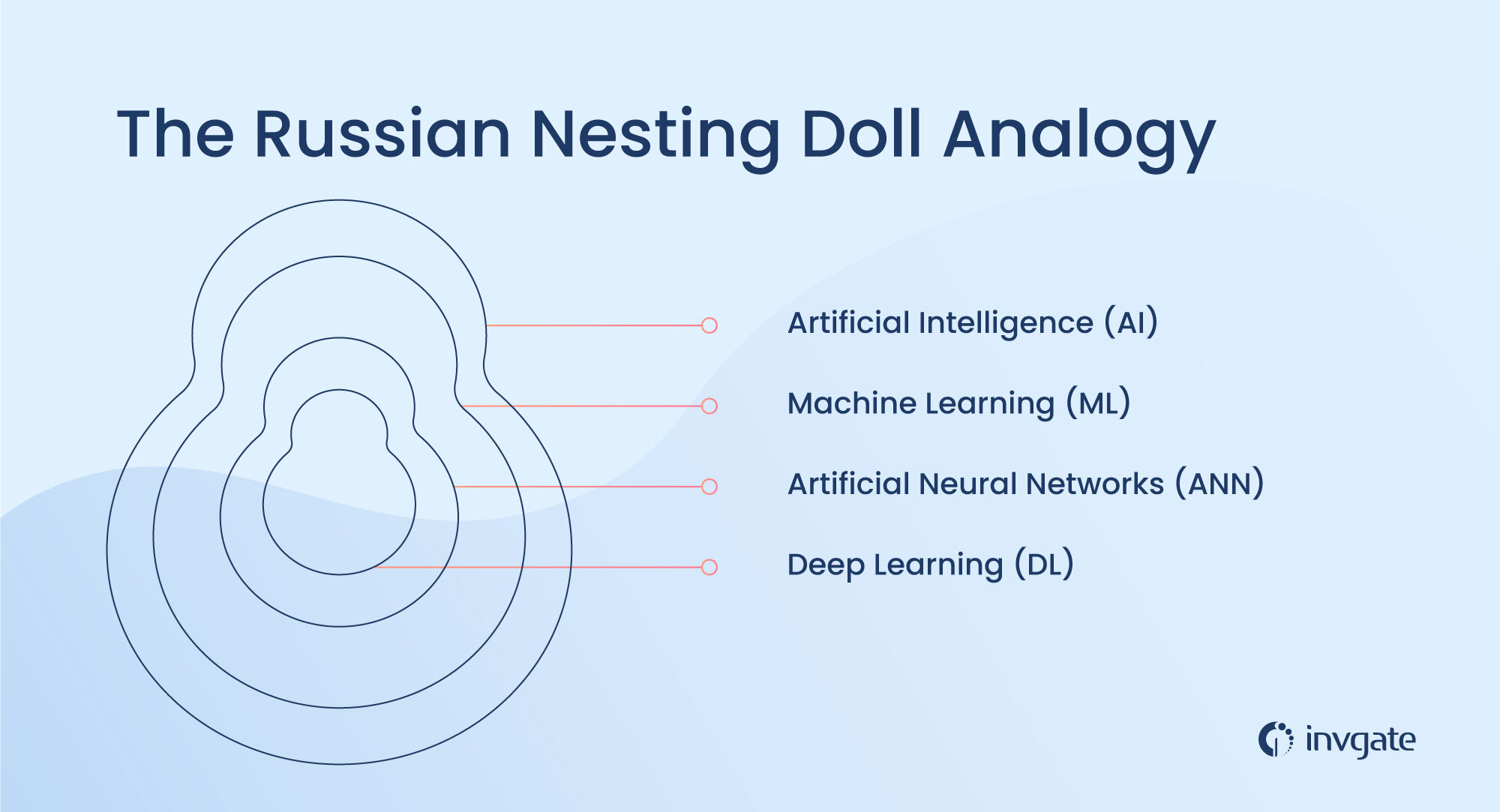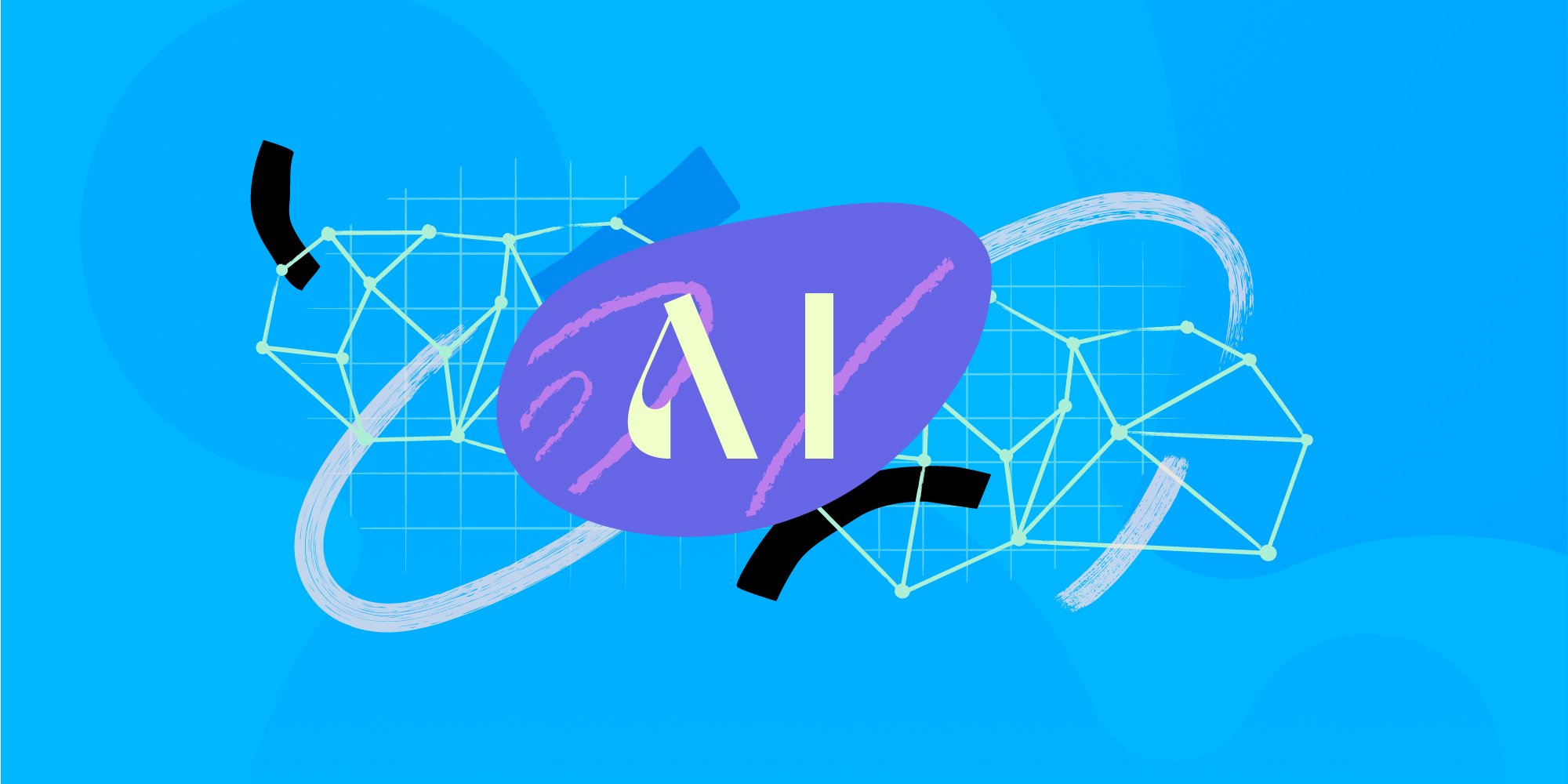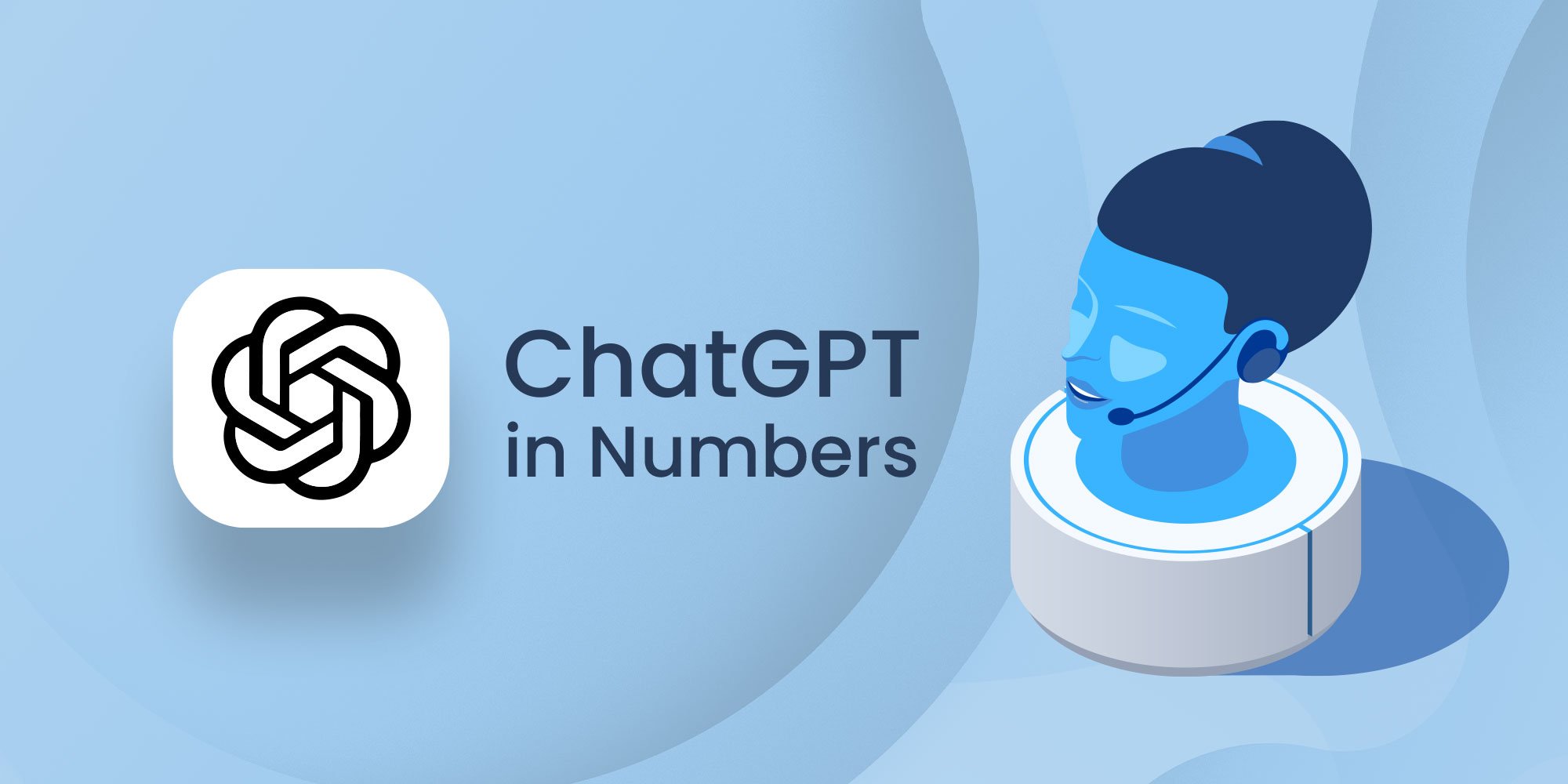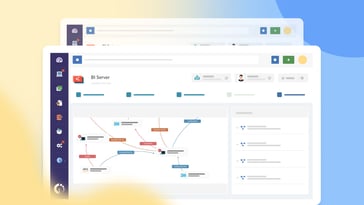The continuous debate around artificial intelligence (AI) has led to a lot of confusion. There are many terms around it that appear to be similar, but when you take a closer look at them, that perception is not entirely accurate. For that reason, here we take our best shot and oppose AI vs. machine learning vs. deep learning vs. neural networks to set them apart once and for a
In short, we'll look at how they all relate to each other, and what makes them different in their particular way. We'll also break down the role of AI in each of these concepts. And now, without further ado, let's plug into the mainframe one more time as we learn about AI and its many branching applications.

AI vs. machine learning vs. deep learning vs. neural networks: How do they relate?
The best way to understand how artificial intelligence, machine learning, neural networks, and deep learning all relate is to use the (already quite famous) Russian nesting doll analogy, which means that these concepts are components of the prior.

In simple terms, machine learning is a subfield of artificial intelligence. Neural networks are a subfield of machine learning. And deep learning algorithms are an advancement in the concept of neural networks.
What separates the concept of neural networks from deep learning is that one is a more complex component of the other.
Let's look at some key differences to understand better how these AI components work.
How is deep learning different from neural networks?
We've talked about how neural networks and deep learning are not necessarily concepts entirely divorced one from the other. When we talk about deep learning, we mean “deep” is the depth of layers and nodes in a neural network. Thus, a neural network consisting of more than three layers (including input and output) is considered a deep learning algorithm.
Another key factor is that most deep neural networks are feed-forward, which means they exclusively flow from input to output. Models can also be trained through backpropagation, allowing them to move in a suitable direction from output to input.
This model lets data science experts calculate and attribute the error associated with each neuron of the network, consequently allowing them to adjust the nodes in the algorithm to reach the desired outcome.
Here are a couple more differences between deep learning and neural networks:
- A deep learning network has many distinct layers, making it more sophisticated than a neural network.
- A deep learning system performs tasks efficiently and effectively, whereas a neural network performs jobs slightly less efficiently than a deep learning system.
- A deep learning unit's main components are an ample power supply, a GPU, and a large RAM. In contrast, a neural network's main components are neurons, learning rate, connections, propagation functions, and weight.
- Due to their complexity, deep learning networks need significant training time, whereas neural networks require little training.

Deep learning vs. machine learning: How are they different?
Before learning about the differences between deep learning and machine learning, it's essential to know that deep learning and machine learning algorithms are not opposing concepts. Instead, deep learning algorithms are, in fact, machine learning algorithms themselves.
As a result, it's better to think about the things that make deep learning unique within machine learning instead of the deep learning vs. machine learning dichotomy. In broad terms, the features that make deep learning unique are its neural network algorithm structure, the lower need for human intervention, and the more extensive data requirements. Let's break them down one by one:
Firstly, traditional machine learning algorithms have a relatively simple structure that includes linear regression or a decision tree model. On the other hand, deep learning models are based on an artificial neural network. These neural networks have many layers, and (just like human brains), they are complex and intertwined through nodes (the neural network equivalent to human neurons).
Secondly, there's the fact that deep learning models require far less human intervention than their regular machine learning counterparts. If we take a self-driving car AI as an example, we could say that its ability to read road signs would be influenced by a software engineer's manual intervention, also known as feature extraction.
This means that they would classify and sort images before feeding them through the neural network input layer, check whether they got the desired output, and adjust the algorithm accordingly if they didn't.
On the other hand, with deep learning models, the feature extraction happens automatically, and the algorithm learns from its errors instead of relying on a software engineer to adjust and perform the feature extraction manually.
Last but not least, there's the fact that deep learning requires much more data than standard machine learning algorithms. Machine learning often works with a thousand data points, while deep learning can work with millions. Because of their complex multi-layer structure, deep learning systems need a large dataset to reduce or eliminate fluctuations and make high-quality interpretations. Organizations evaluating these approaches often work with machine learning consulting services to determine which method best fits their data infrastructure and business requirements.

How does AI fit into things?
Before tackling this question, let's remember what artificial intelligence is.
Artificial intelligence is the capability of a computer system to mimic human cognitive functions such as learning and problem-solving. Through AI, a computer system uses math and logic to simulate people's reasoning to learn from new information and make decisions.
It's a field studied by data scientists for years, and they have been expanding their capabilities more and more with every new hardware and software technological advancement.

So, the quick answer to our initial question is that AI fits into everything related to machine learning, neural networks, and deep learning. But to make ourselves more straightforward, we'll break it down on a case-by-case basis:
AI vs. machine learning
While AI and machine learning are closely connected, they're not the same. Machine learning is considered a subset of AI. It's a similar misconception as those that lead to deep learning vs. machine learning false dichotomies.
Machine learning is the general term for when computers learn from data. It describes the intersection of computer science and statistics where algorithms are used to perform a specific task without being explicitly programmed; instead, they recognize patterns in the data and make predictions once new data arrives.
In general, the learning process of these algorithms can either be supervised learning or unsupervised learning variety, depending on the data being used to feed the algorithms. To learn more about machine learning, check out our piece on machine learning and AI to learn more about it.
AI vs. artificial neural networks
As we've mentioned before, AI refers to machines that can mimic human cognitive skills. Neural networks, on the other hand, refer to a network of artificial neurons or nodes vaguely inspired by the biological neural networks that constitute the human brain.
Neural network systems function similarly to a chain of neurons in humans that receive and process information. Neural networks are built on algorithms found in our brains that aid in their operation.
A neural network interprets numerical patterns that can take the shape of vectors. Neural networks are used to translate these vectors. The primary function of a neural network is to classify and categorize data based on similarities.
The most significant advantage of a neural network is that it can readily adapt to changing output patterns. Also, you don't have to adjust it every time based on the input you supply, which can be achieved through supervised learning or unsupervised learning.

AI vs. deep learning
Artificial Intelligence is the concept of creating innovative, intelligent machines. Deep learning is a subset of machine learning that uses vast volumes of data and complex algorithms to train a model.
Deep learning describes algorithms that analyze data with a logical structure similar to how a human would conclude data science research and trial and error. Note that this can happen through supervised learning and unsupervised learning variety.
To achieve this, deep learning applications use a layered structure of algorithms called an artificial neural network (ANN). The design of such an ANN is inspired by the biological neural network of the human brain, leading to a process of learning that's far more capable than that of standard machine learning models.
Deep learning accuracy can increase with big data
Deep learning can also be used for analyzing massive data sets. The age of technology provides immense opportunities to develop deep learning technology. Deep learning models are usually more accurate as training data increases, although the standard machine learning models such as SVM / Nave Bayes / Classified Model stop improving after saturation points. Deep learning model scales better with more information available.
Key takeaways
In this article, we've explored and clarified concepts of definitions surrounding the universe of AI and its subfields. Most importantly, we've seen the differences between AI vs. machine learning, AI vs. deep learningAI vs. neural networks.
Our initial analogy still stands, as one should not think of these concepts as separate elements but rather as a Russian nesting doll with AI being a giant doll and machine learning, neural networks, and deep learning all their subsequent more miniature dolls.
Another takeaway we'd like you to leave with is how it's crucial to dispel confusion around neural networks vs. deep learning and machine learning vs. deep learning. It's important to remember that deep learning is simply a system of neural networks with more than three layers, and deep learning algorithms are, in fact, machine learning algorithms themselves.
AI and its many subfields are here to stay, and the quicker we can adapt to these changes, the quicker we can truly harness their power and apply it to the world of IT and service desk solutions and predictive analytics. So please, no more fearmongering. Data scientists have already clarified that Skynet, Terminators, and The Matrix apocalypse scenarios won't be happening any time soon!
Frequently Asked Questions
What is the difference between artificial intelligence, machine learning, deep learning, and neural networks?
Machine learning is a subfield of artificial intelligence. Deep learning is a subfield of machine learning, and neural networks make up the backbone of deep learning algorithms. The number of node layers, or depth, of neural networks, distinguishes a single neural network from a deep learning algorithm, which must have more than three.
Is AI the same as neural networks?
No, it's not. It is a widespread misconception because the main difference between AI and neural networks is that AI or artificial intelligence is an entire branch of computer science that works on studying and creating intelligent machines that possess their intelligence. In contrast, a neural network refers to a system of artificial nodes that are made up in coherence with animals' brains to mimic their intelligence somewhat.
Are AI and deep learning the same?
No, they are not. Deep learning is a subset of machine learning. Usually, when people use the term deep learning, they are referring to deep artificial neural networks.
Deep artificial neural networks are a set of algorithms that have set new records in accuracy for many significant problems, such as image recognition, sound recognition, recommender systems, natural language processing, etc.
Is machine learning and AI the same?
No, it's not. Artificial intelligence is the field of computer science that researches methods of giving machines the ability to perform tasks that require human intelligence.
Machine learning is an artificial intelligence technique that gives computers access to massive datasets and teaches them to learn from this data. Machine learning software finds patterns in existing data and applies those patterns to new data to make intelligent decisions.















